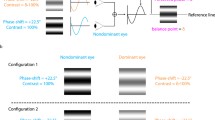Summary
Many patients with acquired strabismus do not suffer from diplopia and confusion after an individually and age-dependent interval. They inhibit the image of the deviated eye by binocular rilvary and particularly by the physiological ability to disregard visually disturbing stimuli.
In strabismus with early onset, binocular rivalry is also demonstrable, even for stimuli that do not normally lead to suppression. On the basis of anomalous retinal correspondence, this rivalry occurs between retinal points onto which the same object projects. The retinal area with the lesser eccentricity receives the dominance. The fovea of the deviated eye is therefore not suppressed. In small-angle strabismus with smaller functional differences between anomalous corresponding retinal points anomalous fusion and even stereopsis can be possible as long as strong suprathreshold stimuli are presented.
Strabismic amblyopia as a consequence of interfoveal suppression can only develop before anomalous retinal correspondence dominates in the strabismic child.
Zusammenfassung
Viele Patienten mit erworbenem Strabismus nehmen nach unterschiedlichem Intervall Diplopie und Konfusion nicht mehr wahr, indem sie die Bildeindrücke des abgewichenen Auges hemmen. Neben dem binokularen Wettstreit spielt hierbei die Fähigkeit des Nichtbeachtens störender visueller Reize eine wesentliche Rolle.
Beim frühkindlichen Strabismus läßt sich ein ausgeprägter binokularer Wettstreit auch für Reize, die bei normalem Binokularsehen keine Hemmung auslösen, nachweisen. Auf dem Boden einer anomalen Netzhautkorrespondenz erfolgt die interokulare Suppression regional zwischen abbildungsgleichen, also normalerweise nicht korrespondierenden Netzhautstellen. Die Dominanz gewinnt die Netzhautstelle mit der geringeren Exzentrizität und damit der größeren kortikalen Neuronenzahl. Die Fovea des abgewichenen Auges wird deshalb nicht supprimiert.
Bei kleinen Schielwinkeln mit geringen Funktionsunterschieden der abbildungsgleichen Netzhautstellen sind eine anomale Fusion und Stereopsis möglich, wenn stark überschwellige Reize dargeboten werden. Eine Schielamblyopie als Folge interfovealer Hemmung kann sich nur entwickeln, bevor bei einem schielenden Kind die anomale Netzhautkorrespondenz überwiegt.
Similar content being viewed by others
Author information
Authors and Affiliations
Rights and permissions
About this article
Cite this article
Herzau, V. Interocular inhibition in strabismus. Ophthalmologe 95, 710–716 (1998). https://doi.org/10.1007/s003470050340
Published:
Issue Date:
DOI: https://doi.org/10.1007/s003470050340




